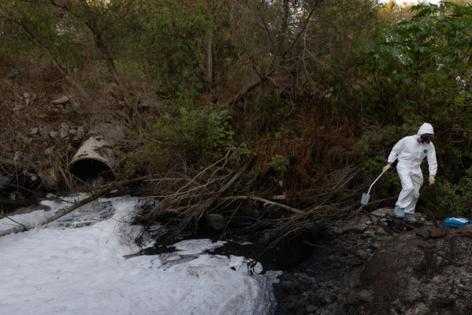First peer-reviewed study of Tijuana River Valley sewage crisis finds link between water pollution and toxic gas in air
Published in News & Features
SAN DIEGO — At its peak concentration levels, the air wafting through the Tijuana River Valley contains thousands of times the typical rate of hydrogen sulfide found in an urban neighborhood, a new study in the journal Science has found.
The familiar, rotten-egg stench of the toxic gas has long been linked to headaches, nausea, difficulty breathing and other symptoms. The effects of such extended exposures to hydrogen sulfide are not fully understood, researchers said.
“Our results validate the community voices that have been saying that air quality near the Tijuana River has been a problem for many years,” said Benjamin Rico, a Ph.D. candidate at UC San Diego and lead author of the report.
The peer-reviewed study published Thursday was supported by the National Science Foundation, the National Oceanic and Atmospheric Administration and the Balvi Philanthropic Foundation.
According to scientists monitoring the unwelcome smells that too often pervade the South County, the spikes in toxic gases have been definitively linked for the first time to the sewage that runs unchecked from Mexico into the United States.
“This study reveals a direct airborne pollutant exposure pathway — from contaminated rivers into the air we breathe,” said Kimberly Prather, the lead investigator and an atmospheric chemist at UC San Diego.
“For the first time, we’ve shown that poor water quality can profoundly degrade air quality, exposing entire communities to toxic gases and other pollutants,” she said. “These findings validate the experiences of residents who have endured this crisis for decades.”
The study also concludes that residents and visitors to the Tijuana River Valley are routinely exposed to 1,700 or more other gases, many of which present similar public health threats due to their toxicity.
“We show here that while hydrogen sulfide is an excellent marker of the sewage impacting area residents, there are multiple sources of waste entering the Tijuana River and a multitude of other hazardous gases that area residents are potentially inhaling,” said Kelly Barsanti, an NSF chemist who also was part of the research team.
The study is the first of its kind to connect poor air quality with nearby polluted bodies of water.
Researchers said the findings raise questions far beyond South San Diego County, where residents have complained for decades about the odors that so often waft across the Tijuana River Valley.
They called for updating air quality models across the globe to monitor emissions from polluted water, because more than half of the world’s population lives near rivers, lakes and oceans and could be facing the same issues.
“Our results show how water and air mix and exchange with one another,” said Prather, the UCSD scientist. “We need to take this into account if we are going to protect people from increasing levels of pollution.”
Millions of gallons of untreated sewage has flowed into the Tijuana River for decades. Much of that waste is pushed out to sea at Imperial Beach, threatening the health of anyone who enters the water and routinely closing the coast to swimmers and surfers.
The scientists set up a series of monitoring stations around the South Bay to collect samples of the air quality in order to study the effects of river sewage on the local air people breathe.
The analysis included three weeks of data that began being collected last September.
In the first 10 days of the study, the Tijuana River was flowing at between 40 million and 80 million gallons per day. The air quality monitors registered peak concentrations of 4,500 parts per billion, or ppb, for at least one minute and up to 2,100 ppb over an hour.
The 2,100 ppb is almost 70 times higher than the California Air Resources Board standard. People exposed to as little as 30 ppb of hydrogen sulfide can begin experiencing headaches, nausea and other symptoms, public health officials say.
On Sept. 10, 2024, the river flow dropped to barely 5 million gallons per day. The study notes that on that day, officials in Mexico activated a pump station south of the border, diverting millions of gallons of wastewater from the U.S.
Researchers noted that the rapid decline in hydrogen sulfide concentrations in the wake of the pump station activation helped prove that the source of the poor air quality is in fact the polluted Tijuana River.
They also pointed out that the number of complaints about odor from South Bay residents spiked on days when the highest concentration of hydrogen sulfide were measured.
Last September proved to be a pivotal time in the years-long fight to clean up the Tijuana River Valley.
The region was suffering a notable heat wave, and hydrogen sulfide levels were significantly elevated. Several UC San Diego and San Diego State University researchers pulled their teams from the field out of concern for their health.
Soon after, one researcher issued what she later acknowledged was an inaccurate report of potentially lethal levels of hydrogen cyanide — a claim that prompted local officials to close schools and U.S. Congress members to renew calls to declare a federal state of emergency.
Amid the public panic, San Diego County health officials said there was no evidence of hydrogen cyanide. They acknowledged an elevated level of hydrogen sulfide but said there was no immediate threat to the public.
By mid-September, state health officials and the U.S. Environmental Protection Agency corroborated the county’s findings, although federal officials later refused to investigate the river as a potential Superfund site.
The competing declarations from private researchers and government health officials pushed the issue of Tijuana sewage to a level of scrutiny it had not received in years — and continues to receive to this day.
In addition to the study’s publication in Science, the local Air Pollution Control District last month released months’ worth of data it collected related to air quality in South Bay communities.
The air district report noted elevated levels of hydrogen sulfide but stopped short of linking the concentration to Tijuana River pollution. One night in April, the district recorded 209 ppb, roughly six times the hourly threshold of 30 ppb.
Once again, the findings coincided with a spate of complaints from residents about pungent smells and a spike in school absences related to asthma and other childhood ailments.
The researchers who produced the Science report included several suggestions to help keep residents safe.
In addition to updating air-quality models to account for pollution from waterways, the scientists said San Diego County should expand a program that provides free air purifiers to people who live in the area.
They also said the study should motivate policymakers to address the polluted water at the core of the air-quality problem.
Researchers also noted that the San Diego Air Pollution Control District maintains an online dashboard showing current hydrogen sulfide levels and also sends out public health alerts when levels climb above 30 ppb.
Scientists William Porter and Karolina Cysneiros de Carvalho of UC Riverside and Paula Stigler Granados of San Diego State contributed to the study.
©2025 The San Diego Union-Tribune. Visit sandiegouniontribune.com. Distributed by Tribune Content Agency, LLC.







Comments